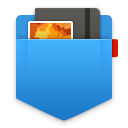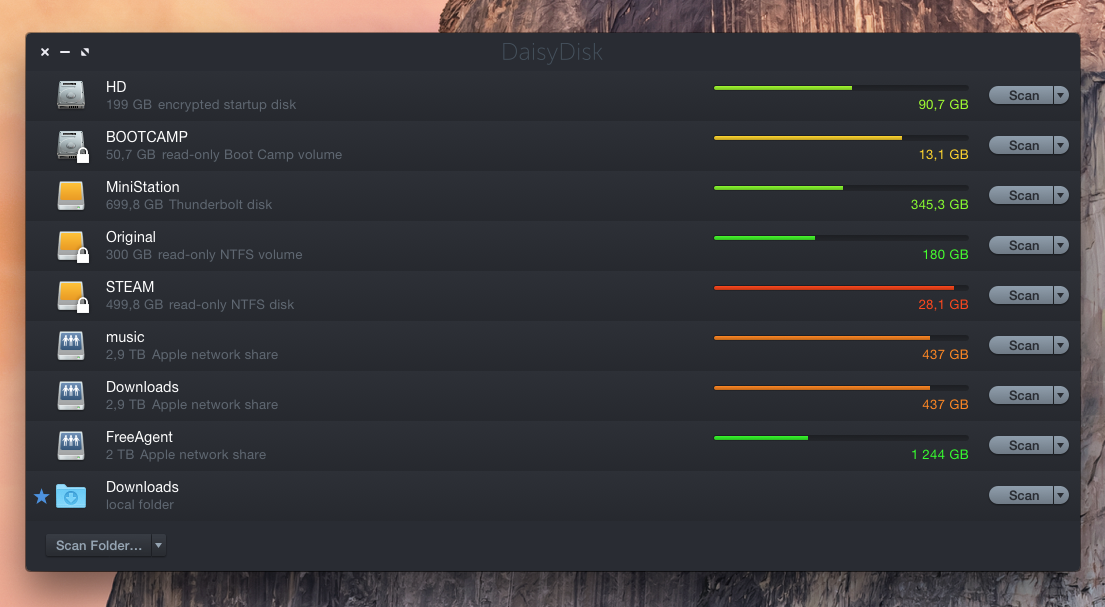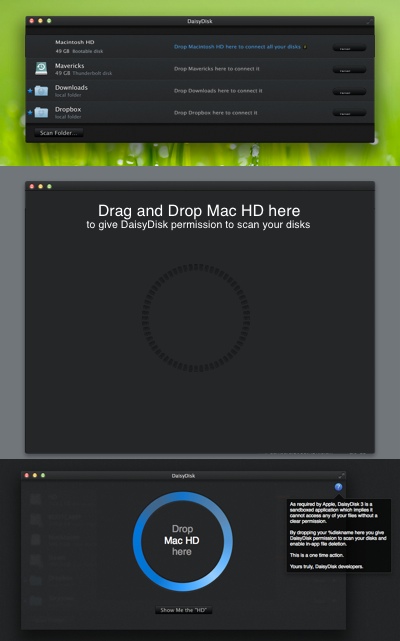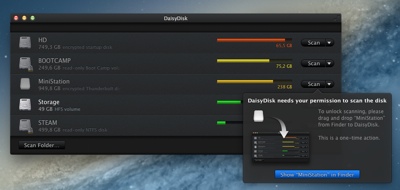DaisyDisk 4.0b8 — release candidate #1
Yeah-ha! We’ve got a release candidate beta (4.0b8). This is your last chance to report bugs before the release :)
Full change log is here.
Yeah-ha! We’ve got a release candidate beta (4.0b8). This is your last chance to report bugs before the release :)
Full change log is here.
Another weekly beta (4.0b7) just released: Download
Full change log is here.
Finally, a new DaisyDisk 4 beta release! We’ve made some major rewrites under the hood, which dramatically boosted DaisyDisk’s scanning speed. In our benchmarks, scanning an SSD is now up to 15x faster! It means you can scan your Macbook’s disk in only 3-6 seconds — almost in no time. A real no-brainer when your disk gets full.
This is the fastest and most efficient DaisyDisk you have ever used. Your beta-testing and feedbacks are welcome: Download DaisyDisk 4 Beta (OS X Yosemite required)
Our benchmarks:
In the following few weeks we’ll be tweaking the beta and submitting the official release to the Mac App Store. A brand new website is also in the pipeline.
DaisyDisk 4 has been in public beta testing for a while already. In the meantime we decided to make this major update even more valuable by adding another important new feature. Of course, this should take us back to development for another few weeks, but we’re sure it’s totally worth it.
Stay tuned!

As promised earlier, the long-awaited update of LilyView 1.1 is now finally live in the Mac App Store.
The update features full OS X Yosemite support as well as the following:
We’re glad to announce that starting from today our Unclutter team separates from Software Ambience and becomes a brand new company, entirely devoted to the Unclutter app, while we stay better focused on our main DaisyDisk and LilyView projects. This is a move that we’ve been planning from the very beginning of Unclutter, which we see as a great idea, but still a side product for us.
We’ve been sharing our vision and expertise with the Unclutter team under the wing of Software Amibence and today we are happy to see that the app has grown strong enough to fly on its own.

From the very beginning, Eugene was and remains committed to developing Unclutter. The website and all contacts for Unclutter stay the same. We remain friends and wish the Unclutter team the best of luck!
Unclutter has become a great tool already and we’re looking forward to the upcoming next major update which will make it even greater. We use this indispensable tool ourselves every day, and recommend it to all Mac users.
Greetings, dear users.
Good news: DaisyDisk 3 is fully compatible with OS X 10.10 Yosemite.
Better news: the upcoming DaisyDisk 4 will be a Yosemite exclusive with an updated look and feel plus some really handy extra features.
Great news: DaisyDisk 4 is free for all users of DaisyDisk 2 and 3.
Availability: December 2014.

Unfortunately, LilyView hasn’t been updated in time. It’s only partially compatible with OS X 10.10 Yosemite and these issues really influence the experience of using the app.
We apologize for the inconvenience and let you know that the update is in the works. Meanwhile we decided to temporarily pull LilyView from the Mac App Store. It will be back after the update is released.
Good news, friends. DaisyDisk 3.0.2 is out.
It adds a workaround for yet-another-Mavericks-bug (sorry for inconvenience) and speaks German 🇩🇪, French 🇫🇷, Italian 🇮🇹, Russian 🇷🇺 and Swedish 🇸🇪.
Download, enjoy and let us know what you think.
Since its very introduction in OS X, app sandboxing has been a pain in the butt for both developers and users. Developers have spent wonderful weeks or even months adopting their software to the new requirements, and users have surely loved the new for-the-sake-of-your-own-security dialogs.
While no doubt being a good idea in theory, Apple’s sandbox implementation leaves much do be desired, not to mention it’s ridden with bugs, which really hurt end users’ experience.
For example, sandboxed applications cannot unmount USB drives even after receiving full access. The bug has been reported to Apple months ago, but it’s still there in Mavericks. A new issue introduced in Mavericks is app’s inability to operate correctly if the sandbox access is granted by drag and drop. The open dialog works, but drag and drop, Mac’s natural way of interacting with things, doesn’t work correctly in Mavericks.
We, as developers, cannot fix sandbox bugs, but we can do one thing: offer all our customers a sandbox-free version of DaisyDisk, which solves all these problems once and for all. Just download DaisyDisk app directly from our site and it will pick up your Mac App Store registration data. In addition to being sandbox-free, the stand-alone version provides some extra features you may find useful.
Since the release of DaisyDisk 3 many Mac App Store users complained about “lost” functionality and inability to scan the disks as they’re used to be. Here’s a short explanation about what’s going on and what we’re doing about this.
As you may already know, some time ago Apple introduced app sandboxing as an extra security measure. In theory, isolating applications prevents hackers from getting your private data or ruining your system, but in practice it has certain drawbacks for both users and developers. The main problem is that from now on all Mac App Store apps are isolated and can’t access most locations on your Mac without clearly receiving your permission. This permission can be provided through the familiar Open panel or by dragging and dropping a file, folder or disk to the app’s main window.
So, what could we do?
The easiest way to apply sandboxing could have been turning the app into a manually populated drop area where in order to view the disk’s capacity or even name one would have to add it first. For many it’s a solution, not for us.
Our problem is that we haven’t spent enough time on current implementation (it’s been finished in a rush) and haven’t tested it too good on real-world cases, so the result is quite confusing. The release version of DaisyDisk 3 is the 4th major iteration of the design, 3 previous ones have been rejected during review process and in fact we’ve spent much more time on app sandbox than we’d liked (we tried at least ten different versions of the UI):
Some of the early sandbox UI prototypes:

We’ve just submitted DaisyDisk 3.0.1 with the following sandbox UI (actual screenshot):

Future updates will likely see even better design. What’s important is a fact that we cannot magically make all your disks just scan as before: DaisyDisk simply doesn’t have permission to access your disks. That’s the face we have to deal with, but we’ll do our best to make the upgrade experience as smooth as possible.
What can you do right now? Drag and drop Macintosh HD to the DaisyDisk’s window to let the app scan all your disks and, if you ask it to, delete files. This is a one time action. Alternatively download and run DaisyDisk version from our site. It can work alongside with the one from Mac App Store, it’s not sandboxed and has more features which cannot be included into the Mac App Store version. If you installed DaisyDisk 3 from the Mac App Store, standalone version will pick up registration information automatically, so you’ll always have all the features without paying extra, no matter where you purchased the application.
Thanks for your patience.
Taras @Software Ambience